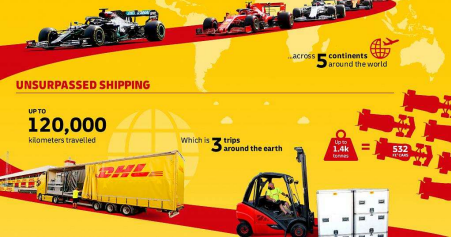Carbon reduction projects will begin immediately to start the journey of becoming a more sustainable sport.
Author: Abhijeet Parmar
Formula 1, the epitome of motorsports since May 1950, has been at the forefront of technological innovations that have directly benefited the wider automotive industry. Formula 1 was seen as a playground for the riches, but over time that image has been replaced by Formula 1 being recognised as the epicentre of passionate and smart individuals, coming together to build the most sophisticated race car every year and leading the automotive world in terms of its technological advancements.
That being said, one cannot deny the fact that like every other motorsport, Formula 1 also contributes to environmental pollution. As per an audit conducted by FIA, the governing body of many auto-racing events including Formula 1, F1’s driving activities produces 256,000 Tonnes of carbon emissions every year. The astonishing fact is that, as per the data from the 2019 season, the cars themselves contributed to only about 0.7% of the total sports emissions, with logistics of transporting teams and equipment across the globe leading to 45%, followed by business travel for teams with 27.7% of total emissions. This figure rounds up with factories and facilities having 19.3% and overall event and operations contributing to the rest of the 7.3% of F1’s emissions.
By the time you would have digested these facts, be ready for more. The above figure of 256,000 tonnes doesn’t even cover the impact of millions of fans travelling across the globe requiring transportation and accommodation. If we were to accommodate their estimate, it amounts to 1.9 million tonnes of CO2 emissions generated by the sport annually.
The more pressing question that comes out of these figures is if Formula 1 is so advanced, why is FIA not doing anything about the negative impact it has on the environment?
On 12th November 2019, FIA announced its plan to hit net-zero carbon footprint by 2030! One begs the question though, how does Formula 1, which is primarily run by an internal combustion engine running on non-renewable fuel, plans to offset more than a million tonnes of carbon emission a year?
The ambitious planning of the FIA started way back in the early 1980s and this plan can be bifurcated into the following phased manner.
1. Sustainable Fuel: Back in 2007, F1 declared to reduce its fuel emissions by more than 50% in consultation with the fuel/oil suppliers of teams like Shell, Petronas, Total, and Mobil. In 2020, F1 announced the introduction of 100% sustainable fuel. The formula for its new fuel is said to be an advanced iteration of bio-fuel which is made of agricultural and industrial waste. As per the F1’s Alternate Fuel Commission, the new fuel will be rolled out in a phased manner with 5.75% biofuel in 2022, 10% in 2025 and 100% biofuel usage by 2030.
2. Efficiency is in the DNA of Formula 1: In 2014, the decision to switch from V8 to V6 was unpleasant to many Formula 1 enthusiasts. Ask any diehard fan about which engine do they like better? You will end up getting the same answer – a bigger and louder V8 engine. But what FIA wanted to achieve with this transition is something that only the sound-minded will understand. Let’s make it simple, going forward. Engine efficiency simply means how much of the fuel is used to run the car vs how much fuel is wasted in combustion and gets converted into heat energy. A normal road car’s engine ranges from 20 to 30% efficiency, meaning only 20% of the total fuel is used to actually run the car, the rest of it is all waste. In Formula 1, the switch from V8 to V6 unlocked the potential from 29% engine efficiency straight to 50% currently. This makes F1 engines the most efficient engines in the world and along with additions of other equipment which uses heat energy from brakes and exhaust to provide extra power to the race cars, the direction in which Formula 1 is heading looks positive.
3. Sponsors and Fans are big contributors: Gone are the days when sustainability focussed companies found no space in Formula 1. BWT, a prestigious sponsor of the Aston Martin Cognizant F1 Team, offers innovative solutions for water purification. Add to that the fact that one of its drivers – Sebastian Vettel, who is a four-time world champion, is using the platform to raise awareness on small contributions we as fans can make towards sustainability. FIA in this regard has committed to using only biodegradable packaging materials at its events instead of plastics with Recycling, Reusing and Composting being the key to its approach.
4. Ultra-efficient logistics: Logistics is the biggest contributor to F1’s emissions. F1 has pledged to move to ultra-efficient logistics practices. Even though more progress is yet to be seen in this regard, all the innovative solutions and start-ups helping motorsports in reducing their carbon footprint should be supported and be promoted as an example for every other industry to follow.
With this, we urge all the growing companies in the field of Solar Energy, Commercial EV Fleet, BioFuel, Biodegradable Packaging Materials, Eco-friendly material handling equipment like Pallets, and FIA to be as aggressive as possible, because now is the time to save the planet earth!
Image source: DHL in partnership with F1
Reference Links: Formula1 Indian Express
Having worked for a couple of racing teams in graduation which aimed at developing efficient powertrains for Formula Student cars, Abhijeet Parmar, Founder of Senergy Pallet Pvt Ltd, is working towards introducing eco-friendly logistics pallets in the APAC region. He is a religious follower of Formula 1 and hopes to associate himself with it in some form or other. In his own words, we often miss out on how much we can learn from motorsports and anime, aimed at the bigger message.














Add Comment